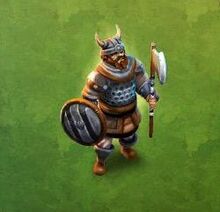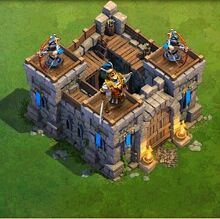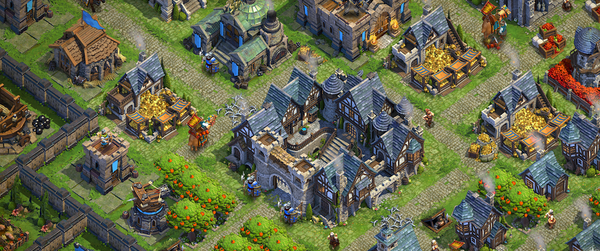Tags: Visual edit apiedit |
Tags: Visual edit apiedit |
||
| Line 14: | Line 14: | ||
In the east, the Eastern Roman Empire also known as the Byzantine Empire had still flourished and had reconquer the lost lands on the Western Roman Empire under Emperor Justinian. They had separated with the Catholic Church and are now Greek Orthodox during the Great Schism. They had defeated the Ostrogoths and the Vandals and settled in these lands. An Islamic caliphate in the Middle East was established by Muslims and conquered lost Roman lands such as Egypt and Iberia. Like the Byzantine Empire; they flourished and grew technological and advanced in science and architecture.[[File:Castle.jpg|thumb|220x220px|The first [[Castle|castles]] were built by the Carolingian Empire. Many European kingdoms would build castles to help fortify cities and strategic positions. Castles would also be housing for the nobility as well. England (a British country) would build castles in Wales (a British country; was conquered by England by King Edward I/Longshanks) as palaces and fortresses for the King. ]] |
In the east, the Eastern Roman Empire also known as the Byzantine Empire had still flourished and had reconquer the lost lands on the Western Roman Empire under Emperor Justinian. They had separated with the Catholic Church and are now Greek Orthodox during the Great Schism. They had defeated the Ostrogoths and the Vandals and settled in these lands. An Islamic caliphate in the Middle East was established by Muslims and conquered lost Roman lands such as Egypt and Iberia. Like the Byzantine Empire; they flourished and grew technological and advanced in science and architecture.[[File:Castle.jpg|thumb|220x220px|The first [[Castle|castles]] were built by the Carolingian Empire. Many European kingdoms would build castles to help fortify cities and strategic positions. Castles would also be housing for the nobility as well. England (a British country) would build castles in Wales (a British country; was conquered by England by King Edward I/Longshanks) as palaces and fortresses for the King. ]] |
||
| − | Back to the West, the Franks, now converted Catholic Christians, had sought to conquer the remains of West Europe. They eventually defeated neighboring Germanic tribes, stopped an Islamic advance at Tours, and covered much of Western Europe forming the Carolingian Empire. The empire had adopted Roman culture, helped gave power to the Latin Catholic Church, helped built monasteries to preserve literature |
+ | Back to the West, the Franks, now converted Catholic Christians, had sought to conquer the remains of West Europe. They eventually defeated neighboring Germanic tribes, stopped an Islamic advance at Tours, and covered much of Western Europe forming the Carolingian Empire. The empire had adopted Roman culture, helped gave power to the Latin Catholic Church, helped built monasteries to preserve literature, increase trade in Europe, and stopped the decay of growth of Western Europe under the rule of the Frankish Emperor Charlemagne. New innovations were created such as the plow and three-field planting. |
In the North, the people living in the Scandinavian Peninsula had pillage towns and villages around the North and Baltic Sea. They raided villages for treasures and food.. They were known as the Vikings. Not all Vikings are bad; many were explorers, farmers, and traders as well. The Vikings had explored and settled in Iceland, Greenland, and parts of North America as well. The Vikings were extremely involved in the network of trade and help gave rose to the economic development of Europe. |
In the North, the people living in the Scandinavian Peninsula had pillage towns and villages around the North and Baltic Sea. They raided villages for treasures and food.. They were known as the Vikings. Not all Vikings are bad; many were explorers, farmers, and traders as well. The Vikings had explored and settled in Iceland, Greenland, and parts of North America as well. The Vikings were extremely involved in the network of trade and help gave rose to the economic development of Europe. |
||
Revision as of 21:56, 14 November 2015
Template:PagecoverTemplate:Minibox
The Medieval Age is the sixth age available to a player in the game of DomiNations. It is obtained by paying 500,000 gold in the Town Center. This age is succeeded by the Gunpowder Age and is preceded by the Classical Age.
Historical Description
The Medieval Age is a period of time of history of new systems, warfare, education, and religious conflicts. This age lasted from 600 AD/CE to the mid-1400 AD/CE. The Medieval Age is split into three periods; the Dark Ages/Early Middle Ages (401-1000 A.D./C.E.), the High Middle Ages (1001-1300 A.D./C.E.), and the Late Middle Ages (1301-1500 A.D./C.E.).

The Vandals were an East Germanic tribe. They were first heard at Poland and was probably immigrated to seek protection from the Huns under Attila the Hun. After being mistreated by the Western Roman Empire, they pushed into the Empire and settled in Iberia. They were then attacked by the Visigoths so they fled to North Africa. They then grew infamous for sacking Rome in 455 AD. Their empire stood in North Africa and parts of Italy but were attacked and defeated by the Eastern Roman Empire.
Dark Ages
To being with, Western Roman Empire was declining the Late Antiquity of the Classical Age ended. Population declined dramatically, literature grew scarce, cities decayed, lack of cultural output, and lack of trade. This became the Early Middle Age or the "Dark Ages", since there were a lot of disadvantages for people living in the West. This age is also known for immigration since the Goths had immigrated settled all around the former-Western Roman Empire. The Visigoths settled in Eastern Iberia, the Ostrogoths settled in Italy, and the Vandals settled in North Africa.
In the east, the Eastern Roman Empire also known as the Byzantine Empire had still flourished and had reconquer the lost lands on the Western Roman Empire under Emperor Justinian. They had separated with the Catholic Church and are now Greek Orthodox during the Great Schism. They had defeated the Ostrogoths and the Vandals and settled in these lands. An Islamic caliphate in the Middle East was established by Muslims and conquered lost Roman lands such as Egypt and Iberia. Like the Byzantine Empire; they flourished and grew technological and advanced in science and architecture.

The first castles were built by the Carolingian Empire. Many European kingdoms would build castles to help fortify cities and strategic positions. Castles would also be housing for the nobility as well. England (a British country) would build castles in Wales (a British country; was conquered by England by King Edward I/Longshanks) as palaces and fortresses for the King.
Back to the West, the Franks, now converted Catholic Christians, had sought to conquer the remains of West Europe. They eventually defeated neighboring Germanic tribes, stopped an Islamic advance at Tours, and covered much of Western Europe forming the Carolingian Empire. The empire had adopted Roman culture, helped gave power to the Latin Catholic Church, helped built monasteries to preserve literature, increase trade in Europe, and stopped the decay of growth of Western Europe under the rule of the Frankish Emperor Charlemagne. New innovations were created such as the plow and three-field planting.
In the North, the people living in the Scandinavian Peninsula had pillage towns and villages around the North and Baltic Sea. They raided villages for treasures and food.. They were known as the Vikings. Not all Vikings are bad; many were explorers, farmers, and traders as well. The Vikings had explored and settled in Iceland, Greenland, and parts of North America as well. The Vikings were extremely involved in the network of trade and help gave rose to the economic development of Europe.
The Viking raids gave fear to many people around Europe. Many people asked nobles for help so the nobles in return asked the people to work for them in exchange of protection. This was how feudalism started. As stated in Wikipedia on the definition of feudalism, "Broadly defined, it was a way of structuring society around relationships derived from the holding of land in exchange for service or labour." Feudalism includes three estates of the realm; the clergy, the nobility, and the peasantry and revolves around three concepts of lords, vassals, and fiefs. Feudalism was encouraged and grew during the reign of Charlemagne.
During the Middle Ages (another name for Medieval Age); knights would serve their lords and kings and would be placed in the army and are required to follow chivalry; a set of rules for knights. These units can attack from horseback or by foot. They would usually fight in exchange for land and a few serfs.
High Middle Ages
At 843 AD/CE, the Carolingian Empire splitted into two kingdoms: France and Germany due to opposing kings concluding the "Dark Ages" and gave rise to the High Middle Ages. During the High Middle Ages, the population grew, education became important, cathedrals and universities were built, society was structured, and cities grew. Architecture, theatre, science, and new arts had been renowned during the age. New weapons were created such as the pike, halberd, and the famous siege unit; the trebuchet.
The High Middle Ages are also known for warfare. The Muslims had captured Christian cities in the Holy Land and banned Christian pilgrimage. In response, the Church created the famed 'Crusades' to recapture back Christian land. The religious conflict was tough and both sides: Christian and Muslim, lost many casualties. The Muslims still had control over the Holy Land but allowed the Christians to lived and to have pilgrimages there.
Late Middle Ages
In the 1300s, a devastating event occurred; the Black Death. The Black Death was a disease that killed 75 million to 200 million people resulting in a decline in feudalism and the power of the Catholic Church. The High Middle Ages died out because of it and the Late Middle Ages begun. During the Late Middle Ages, new arts and sciences were renowned in Italy forming the Renaissance. Warfare was also an interest in the Late Middle Ages. England and France competed for the throne of France in the Hundred-Year War. In the Middle East, the Muslims formed the Ottoman Empire and captured the Byzantine Empire ending the Medieval Age. Gunpowder was discovered in China from the Silk Road. New guns were created changing warfare like never before. The Gunpowder Age had just begun.
Advancements
After advancing to the Medieval Age, players are given a new set of buildings to build, technologies to research, and units to create. Buildings that are available at the Medieval Age are an ambush trap, ballista tower, caltrops, catapult, spike trap, tower, a set of walls, a caravan and a farm, a set of roads, and a castle (new). In the blacksmith, you can upgrade the phalanx (heavy vandal if Germans, samurai if Japanese, heavy legion if Romans) to the pikeman (landsknecht if Germans, heavy samurai if Japanese, Caesar's legion if Romans), the archer (elite longbowman if British, elite chu ko nu if Chinese) to the crossbowman (king's longbowman if British, royal chu ko nu if Chinese), the cavalry raider to the heavy cavalry raider, the cataphract (heavy chevalier if French, royal companion if Greeks) to the knight (elite chevalier if French, heavy royal companion if Greeks), the wall miner to the veteran wall miner, and receive the ballista and the supply cart. In the castle, you can also receive generals. The generals available in this age are Cleopatra and Alexander.
Details
Gallery
Trivia
Further Reading
- Middle Ages at Wikipedia




